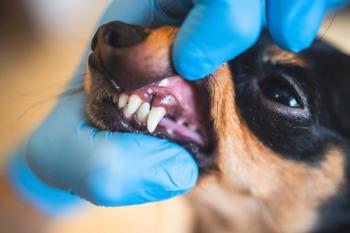
Managing stage I and II periodontal disease (Proceedings)
Prevention and treatment of periodontal disease can only be accomplished through regular professional care under general anesthesia. Multiple steps are involved in this process and the veterinary/technician team plays a vital role in ensuring quality control, efficiency and completeness.
Prevention and treatment of periodontal disease can only be accomplished through regular professional care under general anesthesia. Multiple steps are involved in this process and the veterinary/technician team plays a vital role in ensuring quality control, efficiency and completeness. The following discussion details the essential steps that the quality dentistry service can utilize to ensure proper periodontal prevention and therapy for their patients with an emphasis on stage I and stage II periodontal disease. Stage III and stage IV will be discussed in separate proceedings and lectures.
The following classification of periodontal disease stages from the website of the American Veterinary Dental College
Periodontal Disease Classification
The degree of severity of periodontal disease relates to a single tooth; a patient may have teeth that have different stages of periodontal disease.
• Normal (PD 0): Clinically normal - no gingival inflammation or periodontitis clinically evident.
• Stage 1 (PD 1): Gingivitis only without attachment loss. The height and architecture of the alveolar margin are normal.
• Stage 2 (PD 2): Early periodontitis - less than 25% of attachment loss or at most, there is a stage 1 furcation involvement in multirooted teeth. There are early radiologic signs of periodontitis. The loss of periodontal attachment is less than 25% as measured either by probing of the clinical attachment level, or radiographic determination of the distance of the alveolar margin from the cemento-enamel junction relative to the length of the root.
• Stage 3 (PD 3): Moderate periodontitis - 25-50% of attachment loss as measured either by probing of the clinical attachment level, radiographic determination of the distance of the alveolar margin from the cemento-enamel junction relative to the length of the root, or there is a stage 2 furcation involvement in multirooted teeth.
• Stage 4 (PD 4): Advanced periodontitis - more than 50% of attachment loss as measured either by probing of the clinical attachment level, or radiographic determination of the distance of the alveolar margin from the cemento-enamel junction relative to the length of the root, or there is a stage 3 furcation involvement in multirooted teeth.
Client Communication Before and During the Prophylaxis
Proper phophylaxis is the basis of the approach to preventing stage I teeth from progressing to stage II. Unfortunately we never know what stage of periodontal disease we will be faced with until we have the patient under anesthesia and have utilized probing and radiography to define the extent of disease. Normal gingival does not guarantee normal subgingival tissue. Multiple stages are likely to occur in each individual patient. Premolars may be normal with no gingivitis, tartar or attachment loss while incisors may be mobile and require extraction. Expect this variability and relay it to the client.
Pictures and radiographs of past patients serve a vital role in the communication process. When clients can see what the anticipated disease looks like prior to the actual procedure compliance is much easier to facilitate. Take time to educate clients prior to the procedure. Unexpected findings are much easier to explain while the patient is under anesthesia if the client has seen prior examples of patients with periodontal disease.
As just described a complete oral evaluation under anesthesia many times reveals additional pathology requiring dental radiography and/or further treatment. Therefore it is imperative that owners are available by phone during the procedure so that any abnormalities can be relayed to the owner and permission granted to approach these problems during the same anesthetic episode. It is common to find periodontal pockets that require treatment surrounding what appears to be a normal tooth.
Minimize Patient and Operator Exposure During Prophylaxis
Aerosolization is unavoidable with the use of mechanical scalers during dental prophylaxis exposing both the staff and the patient to oral bacteria. Chlorhexidine solution may be used as a rinse prior to cleaning to decrease this factor and possibly diminish the degree of bacteremia. Protective glasses, gowns and face masks reduce exposure as well and should be worn by the operator. Finally proper insufflation of the endotracheal tube prevents aspiration of microbes by the patient.
Gross Calculus Removal
Calculus removal forceps are used in cases with gross calculus accumulation. Small breed extraction forceps may also be used for this purpose. One tip of the forcep is placed at the ridge of tartar that approximates the gingiva. The other tip is placed on the crown cusp. Careful, controlled force is applied by leveraging the gingival portion of the forcep toward the crown tip to fracture off the calculus mass. Care must be taken not to damage the tooth or the gingiva. The mouth may again be rinsed with chlorhexidine at this point.
Supragingival (Above the Gum) Calculus Removal
Hand scaling is a viable technique for removal of supragingival calculus but has largely been replaced by the use of mechanical scalers. A light feather touch is used with mechanical scalers. This avoids damage to the enamel. Although some micropitting occurs even with a light touch the polishing step will help eliminate this. Make sure that water is constantly bathing the tip to avoid potential thermal damage to the pulp. All tooth surfaces should be thoroughly cleaned with a sweeping or painting motion using the most active portions of the instrument. With both mechanical and hand scaling a modified pen grasp should be used to reduce operator fatigue and maximize operator control of the instrument.
Subgingival (Below the Gum) Calculus Removal
Special tips are available for mechanical units that are designed to be used subgingivally. Supragingival scaling tips will damage the gum tissue and should only be used as designed. Currettes may also be used to clean subgingivally.
Polishing and Lavage
Polishing should include the entire tooth including the subgingival surface. Commercial polishing paste is placed on the tooth and in the prophy cup that is mounted on a prophy angle attached to a slow-speed handpiece. Dipsosable prophy angles with the cup already attached are also available.
Pocket Irrigation
All prophylaxis paste should be removed from the tooth. Gentle saline lavage can be performed subgingivally using a blunt ended canula and a 12 cc syringe or gentle spray from the air/water syringe to remove residual prophy paste and debris. Irrigates including chlorhexidine can be used for this purpose however no studies exist at this time to show any medical benefits over saline.
Periodontal Probing and Charting
Probing and charting helps assess the periodontal status and general oral pathology present in each patient. Information obtained will determine the course of treatment and the indication for dental radiology. Abnormal pocket depths are recorded along with any observable pathology such as missing teeth, abrasion/attrition, fractures, masses etc. The owner should be notified and permission to perform appropriate diagnostics and treatment should be obtained. The largest portion of the technician's ability to impact the future health of the mouth of the patient occurs at this step forward. Stopping the progression of periodontal pockets will eliminate discomfort, systemic complications and eventual tooth loss. Your role in periodontal pocket treatment is an essential component in the overall health of the patient.
Periodontal Pocket Treatment for Stage II Periodontal Disease - Root Planing
Root planning is the first step in treating abnormal periodontal pockets. Curettes used for this purpose are blunt ended hand instruments designed to be used both supragingivally and subgingivally. If periodontal pockets are present and cementum is exposed, tartar may be more tenacious and hard to remove. Hand scaling is used alone or as an adjunct to mechanical scaling to properly remove tartar and debris up to 5 mm subgingivally. If pockets exceed 5 mm the area should, in most cases, be exposed with a periodontal flap to allow proper visualization and instrumentation (stage III). It should be mentioned that this is a surgical procedure and most state laws preclude the technician from performing open periodontal flaps. Many pockets of this depth require bone augmentation, apical positioning flaps or other advanced procedures that will be disussed in the literature and lecture describing stage III and stage IV.
Area specific curettes like the popular Gracey are human instruments that, although not perfect, adapt quite well for use in our veterinary patients. Gracey curettes have only one outer cutting edge (the convex edge) with the face forming a 60-70 degree angle to the shank. With the Gracey only the outer convex cutting edge is used. Gracey's have the advantage of multiple instruments providing different shapes that can adapt to different root configurations.
Curettes are placed in the pocket with the face parallel to the root. Once the bottom of the pocket is reached the instrument is rotated so that the face of the blade is angled at 45-90 degrees. A pull stroke from the pocket to the crown initiates scaling. This sequence is repeated until all calculus and debris are eliminated. The scaling stroke may be vertical, oblique or horizontal.
Following scaling the tooth surfaces should be checked with a dental explorer to ensure no calculus is left behind. Visual inspection may be enhanced by drying the tooth with air to detect residual calculus. Particular attention should be paid to all subgingival surfaces. If this area is left unclean, the only benefit of the entire procedure is a cosmetic one. This is one reason why scaling without anesthesia is contraindicated.
Periodontal Pocket Treatment Stage II Periodontal Disease - Subgingival Curettage
The next step, subgingival curettage, is equally important in treating periodontal pockets. Diseased pocket epithelium contains bacteria, endotoxins, debris and granulation tissue. This tissue tends to bleed easily due to the inflammation caused by the presence of these unwelcome inhabitants. Removal of these is accomplished with the curette as well. The cutting edge is placed in the pocket against the diseased epithelium and used to scrape diseased tissue from the inner wall. This exposes subepithelial connective tissue that can now attach to the tooth root to decrease or eliminate the periodontal pocket. The pocket should now be thoroughly rinsed to eliminate debris and make way for the placement of a perioceutic compound.
Periodontal Pocket Treatment Stage II Periodontal Disease - Perioceutic placement
Cleaning the pocket as described without placement of a perioceutic compound will result in rapid migration of epithelium from the gum margin and recreation of the pocket we are attempting to eliminate. The placement of a perioceutic will eliminate this migration and allow establishment of a tissue bond between the gum and the tooth decreasing or eliminating the pocket. This procedure will be described in the lecture.
Client Communication after the Prophylaxis and Treatment
One important step often neglected is communication following the prophylaxis. This can be done by a knowledgeable staff member or preferably the dental technician. Digital pictures can be taken before and after cleaning and integrated into to a client education sheet that is presented and explained to the client at discharge that require. Areas that require special attention during home care can be shown with arrows on the picture discharge sheet. This is very important in that owner care of areas treated will ensure that the process will not progress to prior disease levels.
It is important to evaluate the severity of the patient's condition in relation to its age to determine the proper interval between prophy's for each individual. A patient with severe periodontal disease may need prophylaxis and periodontal therapy every 3 months whereas a patient with gingivitis or mild periodontitis may only require yearly prophylaxis. Once established this interval is presented to the client at discharge, incorporated into the discharge sheet and an appointment scheduled. This final step not only ensures maximum compliance with rechecks and at-home care it also increases the perception of value of the procedure in the eyes of the client.
The veterinary team's role in ensuring the periodontal health of our patients is an all important one. Established disease in stage II can actually be reversed and pocket depth can be restored to levels enjoyed prior to disease onset. As you have seen opportunities exist to facilitate early therapy and embrace prophylaxis to prevent progression of more severe periodontal changes in our patients.
Reference
Wolf HF, Rateitschak EM, Rateitschak KH et al. Color atlas of dental medicine: periodontology, 3rd ed. Stuttgart: Georg Thieme Verlag, 2005
Newsletter
From exam room tips to practice management insights, get trusted veterinary news delivered straight to your inbox—subscribe to dvm360.






